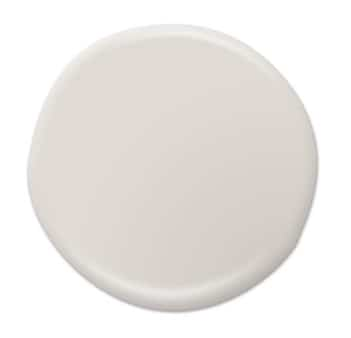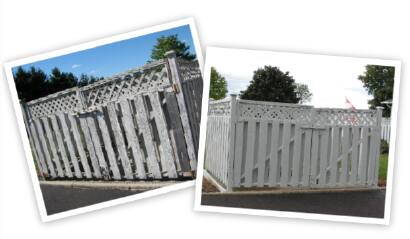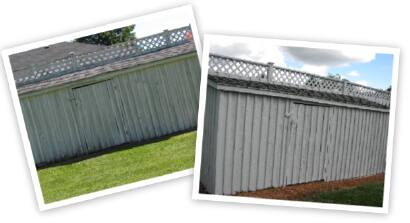When it comes to
outdoor painting projects, we're getting down to the wire -- at least as far as 2012 is concerned. For me, that
pressing deadline for exterior updates meant finally
tackling the fence around my pool: a chore that I'd been putting off all summer, only to realize a few weeks back that if I put it off any longer, it would be snow that was flying, and not just leaves!
 Why does summer already feel like such a distant memory? This shot of the fence surrounding the pool and deck is actually pretty forgiving. (Doesn't everything look better under a clear blue sky?) Detail shots below will show just how badly seven winters have degraded the last coat of stain...Photography by Brett Walther.
Why does summer already feel like such a distant memory? This shot of the fence surrounding the pool and deck is actually pretty forgiving. (Doesn't everything look better under a clear blue sky?) Detail shots below will show just how badly seven winters have degraded the last coat of stain...Photography by Brett Walther.
The fence is a basic
wooden plank construction that surrounds the pool and patio area, providing privacy and a bit of shelter from the breeze. Although it's about 15 years old, it remains in very good shape -- structurally, that is. The problem? It's been about seven years since it was last stained, and it's definitely showing signs of wear...
 See what I mean? Worn, weathered, and in desperate need of some TLC. The seven-year-old stain is now fading fast, and, in certain sun-starved patches, dampness has got into the wood, paving the way for mould, mildew and discolouration. Photography by Brett Walther.
See what I mean? Worn, weathered, and in desperate need of some TLC. The seven-year-old stain is now fading fast, and, in certain sun-starved patches, dampness has got into the wood, paving the way for mould, mildew and discolouration. Photography by Brett Walther.
And it wasn't just the two-sided
fence that needed a crisp coat of solid colour stain. Oh no -- I also needed to freshen up the board-and-batten style
patio bar, as well as the
pumphouse and
paddock in the backyard, which, when I did the math via online paint calculator, added up to a whopping
11 gallons of stain.
ELEVEN! No wonder I put this off for so long, right? To tackle a project this size, I called my pal
Nancy Bollefer of
Behr Paints. Nancy's painted more spaces than just about anyone I know, so I bowed to her expertise in recommending the right products for the job, and the insider tips on how to properly prep this coat of stain so that it would last longer than the seven years I got out of the last application. Here's Nancy's
three-step formula for re-staining a fence:
Step 1: Apply Behr Premium Wood Stain and Finish Stripper.
The first step --
stripping -- is perhaps everyone's least favourite. (And yes, I fall into that category myself!) Nevertheless, if you want your stain to stick around for more than a single season, it's a recommended jumping-off point, as stripper helps to
remove loose wood fibres, and any
lingering coatings and
oil or latex paints on the wood's surface. "You definitely need this stripper if any of the existing stain is lifting, not sound or peeling," says Nancy. Working one small section at a time, apply the stripper with a pump sprayer, then scrub the surface with a stiff bristle broom. Rinse thoroughly with a pressure washer, then repeat the process as needed.
Step 2: Apply Behr Premium All-in-One Wood Cleaner. Even if you decide to forgo stripping, you definitely need to use a
wood cleaner, says Nancy. This product will help
clean and
brighten the wood surface, and takes care of that
icky mould and mildew -- the source of so much of the discolouration on my fence. After applying the cleaner with a pump sprayer and working the solution into the wood with a stiff bristle broom, rinse it thoroughly with a pressure washer and allow it to dry before tackling the final step...
Step 3: Apply Behr Premium Solid Colour Stain. At last -- the (relatively) fun part: choosing a
colour! I really liked what remained of the existing stain colour (and definitely wanted solid-colour coverage as opposed to a translucent stain), so opted for
Behr Premium Solid Colour Stain in
Cape Cod Gray SC365.
 My colour choice: Behr Paints Solid Colour Stain in Cape Cod Gray SC365. It's a super-pretty dove grey that works really well with the mortar in the white brick facade of my home. Photography courtesy of Behr.
My colour choice: Behr Paints Solid Colour Stain in Cape Cod Gray SC365. It's a super-pretty dove grey that works really well with the mortar in the white brick facade of my home. Photography courtesy of Behr.
Make sure the wood surface you're staining is
completely dry, and -- particularly important as we head deeper into fall --
check the weather before you load up your brush. Nancy suggests waiting for a forecast of 24 rain-free hours following application.
 At left, a section of the fence that's been stripped, primed and stained. At right, the fence in its original condition. Photography by Brett Walther.
At left, a section of the fence that's been stripped, primed and stained. At right, the fence in its original condition. Photography by Brett Walther.
That final step involves a lot of hard work, but it totally pays off. Just
take a look at the transformation...








And that's a wrap -- except now it's time to close the pool for the season! No rest for the wicked... Photography by Brett Walther. Talk about a burden lifted! It's
such a relief to know that my deck is ready for entertaining as soon as the mercury rises next season. Which
home improvements are you scrambling to complete this
autumn?
Follow me on Twitter!
Don't miss out -- subscribe to Canadian Living's Home & Garden blog!

 Why does summer already feel like such a distant memory? This shot of the fence surrounding the pool and deck is actually pretty forgiving. (Doesn't everything look better under a clear blue sky?) Detail shots below will show just how badly seven winters have degraded the last coat of stain...Photography by Brett Walther.
Why does summer already feel like such a distant memory? This shot of the fence surrounding the pool and deck is actually pretty forgiving. (Doesn't everything look better under a clear blue sky?) Detail shots below will show just how badly seven winters have degraded the last coat of stain...Photography by Brett Walther. See what I mean? Worn, weathered, and in desperate need of some TLC. The seven-year-old stain is now fading fast, and, in certain sun-starved patches, dampness has got into the wood, paving the way for mould, mildew and discolouration. Photography by Brett Walther.
See what I mean? Worn, weathered, and in desperate need of some TLC. The seven-year-old stain is now fading fast, and, in certain sun-starved patches, dampness has got into the wood, paving the way for mould, mildew and discolouration. Photography by Brett Walther. My colour choice: Behr Paints Solid Colour Stain in Cape Cod Gray SC365. It's a super-pretty dove grey that works really well with the mortar in the white brick facade of my home. Photography courtesy of Behr.
My colour choice: Behr Paints Solid Colour Stain in Cape Cod Gray SC365. It's a super-pretty dove grey that works really well with the mortar in the white brick facade of my home. Photography courtesy of Behr. At left, a section of the fence that's been stripped, primed and stained. At right, the fence in its original condition. Photography by Brett Walther.
At left, a section of the fence that's been stripped, primed and stained. At right, the fence in its original condition. Photography by Brett Walther.



 And that's a wrap -- except now it's time to close the pool for the season! No rest for the wicked... Photography by Brett Walther. Talk about a burden lifted! It's
such a relief to know that my deck is ready for entertaining as soon as the mercury rises next season. Which
home improvements are you scrambling to complete this
autumn?
Follow me on Twitter!
Don't miss out -- subscribe to Canadian Living's Home & Garden blog!
And that's a wrap -- except now it's time to close the pool for the season! No rest for the wicked... Photography by Brett Walther. Talk about a burden lifted! It's
such a relief to know that my deck is ready for entertaining as soon as the mercury rises next season. Which
home improvements are you scrambling to complete this
autumn?
Follow me on Twitter!
Don't miss out -- subscribe to Canadian Living's Home & Garden blog!

















Comments